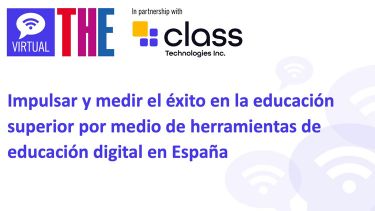Digital learning tools are transforming the way universities teach to enhance student engagement, but faculty support is critical to realise the full potential of new edtech platforms
For many universities, digital transformation is as much a cultural shift as it is a technological one. For others, it might be a question of resources. All, however, are working to deliver teaching and learning that is flexible, accessible and supports student growth and well-being. But how does that look in practice?
At a webinar hosted by Times Higher Education in partnership with Class, higher education experts shared their insights into blended learning, endorsing the capability of digital tools to revolutionise the student experience. Massimo Gentili, head of EMEA at edtech provider Class, spoke of the need for robust platforms that could support and measure student engagement, and tools that could be scalable, efficient and user-friendly.
“We believe that we should provide our customers and our end users with the tools that should enable their teaching and learning,” Gentili said. “Even in cases where some faculty members may be a little sceptical about technology, by implementing Class they can see a jump in the level of interactivity with their students, and this has a measurable impact on student success.”
Class allows universities to run virtual classrooms on a Zoom platform enhanced by interactive teaching and learning tools. Interactivity is key to maintaining the human element of teaching when transitioning to online delivery. Richard Osborne, faculty learning technology lead at UCL, said online platforms such as Zoom allowed educators to be more creative.
“It wasn’t designed to meet the needs of educators in the way that it has; but it has, without question, become the number one tool for my academic colleagues across UCL, and we’re sticking with it,” he said. “I find it fascinating how they have used it not only for delivering teaching but for asynchronous teaching, using it as a recording studio for their own work.”
Jolly Sahni, director of the Jubilation Office and associate director of the MBA programme at Prince Sultan University, agreed. She argued that digital tools empowered the student and educator alike. “Using digital tools is going to give you tremendous power, and the change which I do see is a lot of enthusiasm,” she said. “Technology is a solution to many of the challenges which were not possible to overcome in face-to-face learning.”
At Prince Sultan University, business simulators are used to enhance assessment, with personalised, real-time feedback available via learning analytic plug-ins on the learning management system.
Hazzaa Al Shareef, vice-president of academic affairs at Saudi Electronic University, said technology was creating a more efficient assessment process. “This will speed up the learning process in general and help organisations in assessing and achieving the learner outcomes,” he said.
But the success of digital learning tools was contingent on academic buy-in. Support through faculty upskilling and reskilling was imperative. Similarly, students need to be familiarised with the blended learning environment. Omar Al-Jarrah, vice-president for planning and development at the Arab Open University, said his institution offered training programmes at the start of each academic year to improve access for students who might otherwise be unable to participate in higher education.
The panel:
- Omar Al-Jarrah, vice-president for planning and development, Arab Open University
- Hazzaa Al Shareef, vice-president of academic affairs, Saudi Electronic University
- Massimo Gentili, head of EMEA, Class
- Richard Osborne, faculty learning technology lead, UCL
- Alistair Lawrence, special projects editor, Times Higher Education (chair)
- Jolly Sahni, director of the Jubilation Office and associate director of the MBA programme, Prince Sultan University
Watch the webinar on demand above or on the THE Connect YouTube channel.
Find out more about Class.



